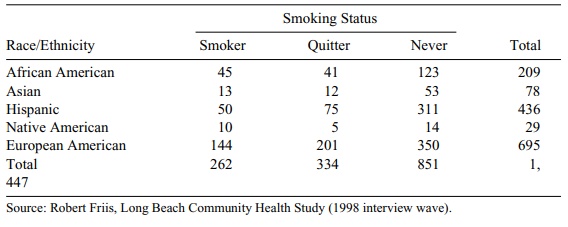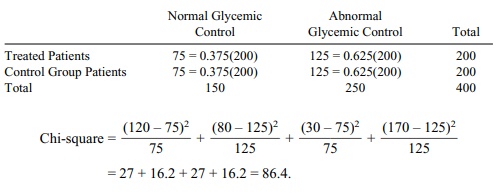Exercises questions answers
| Home | | Advanced Mathematics |Chapter: Biostatistics for the Health Sciences: Categorical Data and Chi-Square Tests
Biostatistics for the Health Sciences: Categorical Data and Chi-Square Tests - Exercises questions answers
EXERCISES
11.1 State in your words definitions of the following
terms:
a. Chi-square
b. Contingency table (cross-tabulation)
c. Correlated proportions
d. Odds ratio
e. Goodness of fit test
f. Test for independence of two variables
g. Homogeneity
11.2 A hospital accrediting agency reported that the
survival rate for patients who had
coronary bypass surgery in tertiary care centers was 93%. A sample of community
hospitals had an average survival rate of 88%. Were the survival rates for the
two types of hospitals the same or different?
11.3 Researchers at an academic medical center performed
a clinical trial to study the
effectiveness of a new medication to lower blood sugar. Diabetic patients were
assigned at random to treatment and control conditions. Patients in both groups
received counseling regarding exercise and weight loss.
TABLE 11.16. Cross-Tabulation of Lifetime Smoking and Self-Reported
Health Status

Among the sample of 200 treatment patients, 60% were found to
have normal fasting blood glucose levels at follow-up. Among an equal number of
controls, only 15% had normal fasting blood glucose levels at follow-up.
Demonstrate that the new medication was effective in treating hyperglycemia.
11.4 In a community health survey, individuals were
randomly selected for partic-ipation in a telephone interview. The study used a
cross-sectional design. Table 11.16 shows the results for the cross-tabulation
of cigarette smoking and health status. Determine whether the relationship
between smoking 100 cigarettes during one’s life and self-reported health
status is statistically sig-nificant at the a = 0.05
level.
11.5 In the community health survey described in the
previous exercise, respon-dents’ smoking status was classified into three
categories (smoker, quitter, never smoker). Table 11.17 shows the results for
the cross-tabulation of smoking status and health status. Determine whether the
relationship is statis-tically significant at the α = 0.05 level. Compare your results with those ob-tained in the previous
exercise.
11.6 In the same community health survey, the
investigators wanted to know whether
smoking status varied according to race/ethnicity. Race was mea-sured according
to five categories (African American, Asian, Hispanic, Na
TABLE 11.17. Cross-Tabulation of Smoking Status and Self-Reported Health
Status

TABLE 11.18. Cross-Tabulation of Race/Ethnicity and Self-Reported Health
Status

11.7 In the community health survey, the investigators
studied the relationship be-tween alcohol drinking status (defined according to
four categories) and smok-ing status (defined according to three categories).
Alcohol drinking status was classified according to the categories of current
drinker, former drinker, occasional drinker, and never drinker. Table 11.19
shows the resulting cross-tabulation. Inspect the data shown in the table. Do
you think that there is an association between alcohol drinking status and
smoking status? Confirm your subjective impressions by performing a statistical
test at the α = 0.05 level.
11.8 A multiphasic health examination was administered
to 1000 employees of a pharmaceutical
firm. 50% of these employees had elevated diastolic blood pressure and 45% had
hypoglycemia. A total of 37% of employees had both elevated diastolic blood
pressure and hyperglycemia. Create a 2 × 2 contingency table and fill in all
cells of the table. Is the association between hyper-tension and hyperglycemia
statistically significant?
TABLE 11.19. Cross-Tabulation of Smoking Status and Alcohol Drinking
Status

Answers:
11.3

Yes if the treatment was ineffective we would see
independence in the 2 × 2 table and approximatelyonly approximately 37.5% or 75
students would have normal control in each group. We would expect 37.5% or
about 75 to be normal on one test and the same 75 on the other. So the expected
table would be as follows:

Chi-square = (120 – 75)2 / 75 + (80 –
125)2 / 125 + (30 – 75)2 / 75 + (170 – 125)2 /
125
= 27 + 16.2 + 27 + 16.2 = 86.4.
Since we are looking at a chi-square statistic with
1 degree of freedom, we should clearly reject independence in favor of the
conclusion that the treatment is effective.
11.4 We recall that the chi-square test applies to
testing independence between two
groups. The expected frequencies are the row total times the column total
di-vided by the total sample size. So in the survey, the participants’ health
as self-re-ported versus having smoked 100 or more cigarettes or not in their
lifetime should have about the same distribution in each column. So in the
first row, for example, E = 632(369)/1489
= 156.62 for the participants who smoked 100 or more cigarettes and E = 857(369)/1489 = 212.38 for those
that smoked less than 100 cigarettes. Continuing in this way the table looks as
follows:

Summing (O –
E)2/E we get 1.36 +
1.01 + 0.026 + 0.214 + 0.167 + 0.123 = 2.9. Since this table has 3 rows and 2
columns, the degrees of freedom for the chi-square is (R – 1)(C – 1) = 2(1) = 2.
Checking the 5% critical value in the chi-square table, we see that C = 5.991, and since 2.9 < 5.991, we
cannot reject the null hypothesis that the distribution of health status for is
the same for those that smoked 100 or more cigarettes compared with those that
did not smoke 100 or more cigarettes. Al-though it may be surprising that the
distributions are so similar, it only indicates that they perceive their health
similarly. Their actual health status by other measures could be considerably
different.
11.7 The approach is the same as in 11.4 except that R = 2 and C = 2. So the chi-square statistic will have only 1 degree of
freedom. First we must construct the table as follows:

This is what we are given for the table. We can
fill in the remaining cells by sub-traction since we know the totals for the
first row, the first column, and the grand total:

Now we compute the expected numbers and compute the
chi-square statistic:

Inspection of the table shows a very poor fit.
Computing chi-square we have (145)2/225 + (145)2/275 +
(145)2/225 + (145)2/275 = 93.44 + 76.45 + 93.44 + 76.45 =
339.79. The critical value at the 1% level for a chi-square with 1 degree of
freedom is C = 6.635. So clearly we
reject the null hypothesis. There is a strong relationship between elevated
diastolic blood pressure and hypoglycemia for this population.
Related Topics
